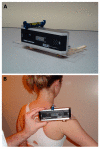Assessment of scapulohumeral rhythm for scapular plane shoulder elevation using a modified digital inclinometer
- PMID: 22720268
- PMCID: PMC3377910
- DOI: 10.5312/wjo.v3.i6.87
Assessment of scapulohumeral rhythm for scapular plane shoulder elevation using a modified digital inclinometer
Abstract
Aim: To develop a better understanding of scapulohumeral rhythm during scapular plane shoulder elevation.
Methods: Thirteen healthy, college-aged subjects participated in this study. Subjects were free from any upper extremity, neck or back pathology. A modified digital inclinometer was utilized to measure scapular upward rotation of the subject's dominant shoulder. Upward rotation was measured statically as subjects performed clinically relevant amounts of shoulder elevation in the scapular plane. Testing order was randomized by arm position. Scapular upward rotation was assessed over the entire arc of motion and over a series of increments. The percent contributions to shoulder elevation for the scapula and glenohumeral joint were calculated. Scapulohumeral rhythm was assessed and represented the ratio of glenohumeral motion to scapulothoracic motion (glenohumeral elevation: scapular upward rotation). A one-way ANOVA was used to compare scapular upward rotation between elevation increments.
Results: Scapulohumeral rhythm for the entire arc of shoulder elevation was equal to a ratio of 2.34 :1 and ranged from 40.01:1 to 0.90:1 when assessed across the different increments of humeral elevation. Total scapular motion increased over the arc of shoulder elevation. The scapula contributed 2.53% of total motion for the first 30 degrees of shoulder elevation, between 20.87% and 37.53% for 30(o)-90(o) of shoulder elevation, and 52.73% for 90(o)-120(o) of shoulder elevation. Statistically significant differences in scapular upward rotation were identified across the shoulder elevation increments [F((3,48)) = 12.63, P = 0.0001].
Conclusion: Clinically, we must recognize the usefulness of the inclinometer in documenting the variable nature of scapulohumeral rhythm in healthy and injured shoulders.
Keywords: Biomechanics; Kinematics; Scapula; Shoulder.
Figures



Similar articles
-
The comparison of scapular upward rotation and scapulohumeral rhythm between dominant and non-dominant shoulder in male overhead athletes and non-athletes.Man Ther. 2015 Dec;20(6):758-62. doi: 10.1016/j.math.2015.02.010. Epub 2015 Mar 5. Man Ther. 2015. PMID: 25795109
-
How Do Scapulothoracic Kinematics During Shoulder Elevation Differ Between Adults With and Without Rotator Cuff Arthropathy?Clin Orthop Relat Res. 2020 Nov;478(11):2640-2649. doi: 10.1097/CORR.0000000000001406. Clin Orthop Relat Res. 2020. PMID: 32694316 Free PMC article.
-
Three-Dimensional Scapular Kinematics in Patients with Reverse Total Shoulder Arthroplasty during Arm Motion.Clin Orthop Surg. 2016 Sep;8(3):316-24. doi: 10.4055/cios.2016.8.3.316. Epub 2016 Aug 10. Clin Orthop Surg. 2016. PMID: 27583116 Free PMC article.
-
Scapular positioning and movement in unimpaired shoulders, shoulder impingement syndrome, and glenohumeral instability.Scand J Med Sci Sports. 2011 Jun;21(3):352-8. doi: 10.1111/j.1600-0838.2010.01274.x. Epub 2011 Mar 8. Scand J Med Sci Sports. 2011. PMID: 21385219 Review.
-
Shoulder muscle activity and function in common shoulder rehabilitation exercises.Sports Med. 2009;39(8):663-85. doi: 10.2165/00007256-200939080-00004. Sports Med. 2009. PMID: 19769415 Review.
Cited by
-
Alteration of muscle activity during voluntary rehabilitation training with single-joint Hybrid Assistive Limb (HAL) in patients with shoulder elevation dysfunction from cervical origin.Front Neurosci. 2022 Nov 9;16:817659. doi: 10.3389/fnins.2022.817659. eCollection 2022. Front Neurosci. 2022. PMID: 36440285 Free PMC article.
-
Coracoacromial ligament integrity influences scapular spine strain after reverse shoulder arthroplasty.JSES Int. 2024 Nov 14;9(1):283-289. doi: 10.1016/j.jseint.2024.10.012. eCollection 2025 Jan. JSES Int. 2024. PMID: 39898219 Free PMC article.
-
Prevalence of Scapular Dyskinesis in Overhead and Nonoverhead Athletes: A Systematic Review.Orthop J Sports Med. 2016 Feb 17;4(2):2325967115627608. doi: 10.1177/2325967115627608. eCollection 2016 Feb. Orthop J Sports Med. 2016. PMID: 26962539 Free PMC article.
-
Scapular Upward Rotation During Passive Humeral Abduction in Individuals With Hemiplegia Post-stroke.Ann Rehabil Med. 2019 Apr;43(2):178-186. doi: 10.5535/arm.2019.43.2.178. Epub 2019 Apr 30. Ann Rehabil Med. 2019. PMID: 31072084 Free PMC article.
-
Serratus anterior palsy as a Masquerader: utilizing novel digital dynamic radiography for diagnosis and treatment response.JSES Int. 2024 Jan 11;8(3):540-545. doi: 10.1016/j.jseint.2023.12.001. eCollection 2024 May. JSES Int. 2024. PMID: 38707553 Free PMC article. No abstract available.
References
-
- Kibler WB. The role of the scapula in athletic shoulder function. Am J Sports Med. 1998;26:325–337. - PubMed
-
- Itoi E. Scapular inclination and inferior stability of the shoulder. J Shoulder Elbow Surg. 1992;1:131–139. - PubMed
-
- Weiser WM, Lee TQ, McMaster WC, McMahon PJ. Effects of simulated scapular protraction on anterior glenohumeral stability. Am J Sports Med. 1999;27:801–805. - PubMed
-
- Codman E. Chapter II: Normal motions of the shoulder. Boston, MA 1934, 32-63.
LinkOut - more resources
Full Text Sources
Miscellaneous

